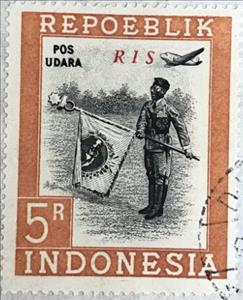Stamp: Bannerman and Airplane (Indonesia 1949)
Bannerman and Airplane (Indonesia 1949)
01 January (Indonesia ) within release Vienna Printings - RepOEblik - RIS goes into circulation Stamp Bannerman and Airplane face value 5 Indonesian rupiah
| Stamp Bannerman and Airplane in catalogues | |
|---|---|
| Dai Nippon: | Dai: ID 51-11l |
Stamp is square format.
Overprint (RIS) in redAlso in the issue Vienna Printings - RepOEblik - RIS:
- Stamp - Airplane and Flag face value 4.50;
- Stamp - Airplanes Breaking the Blockade face value 30;
- Stamp - Airplanes Breaking the Blockade face value 1;
- Stamp - Airplanes Breaking the Blockade face value 1;
- Stamp - Arrival of a Ship face value 50;
- Stamp - Bannerman and Airplane face value 5;
- Stamp - Bannerman and Airplane face value 5;
- Stamp - Bannerman and Airplane face value 5;
- Stamp - Bannerman and Airplane face value 1;
- Stamp - Blockade Airplane face value 2.50;
- Stamp - Boy with Pineapple face value 80;
- Stamp - Buffalo Canyon face value 75;
- Stamp - Construction of Great Postal Road, Java face value 15;
- Stamp - Discussing Pilots face value 1;
- Stamp - Djanger Dancer from Bali face value 30;
- Stamp - Hot Springs, Java face value 2.50;
- Stamp - Hot Springs, Java face value 1.50;
- Stamp - Lake Region face value 40;
- Stamp - Mosque in Medan face value 2;
- Stamp - Mountain Landscape face value 60;
- Stamp - Pilots face value 30;
- Stamp - Plane Over Lakes face value 4.50;
- Stamp - Plane Over Lakes face value 4.50;
- Stamp - President Sukarno face value 25;
- Stamp - President Sukarno face value 25;
- Stamp - President Sukarno face value 25;
- Stamp - President Sukarno face value 25;
- Stamp - Red Cross Airplane face value 50;
- Stamp - Red Cross Boeing Aircraft face value 20;
- Stamp - Red Cross Nurse with Wounded Soldier face value 7.50;
- Stamp - Rice Farmers face value 35;
- Stamp - Ships Breaking the Blockade face value 10;
- Stamp - Ships Breaking the Blockade face value 25;
- Stamp - Ships Breaking the Blockade face value 25;
- Stamp - Special Services face value 40;
- Stamp - Sumatra Mountain face value 50;
- Stamp - Sumatra Mountain face value 50;
- Stamp - Unloading of a Blockade Vessel face value 15;
- Stamp - Unloading of a Blockade Vessel face value 60;
- Stamp - Vice President M. Hatta face value 10;
- Stamp - Vice President M. Hatta face value 10;
- Stamp - Vice President Muhammad Hatta face value 10;
- Stamp - Vice President Muhammad Hatta face value 10;
- Stamp - Warplane face value 10;
- Stamp - Watching Soldier face value 20;
- Stamp - Watching Soldier face value 20;
|
Data entry completed
53%
|
|
|---|---|
| Stamp Bannerman and Airplane in digits | |
| Country: | Indonesia |
| Date: | 1949-01-01 |
| Print: | Recess |
| Emission: | Air Post |
| Format: | Stamp |
| Face Value: | 5 Indonesian rupiah |
Stamp Bannerman and Airplane it reflects the thematic directions:
An aircraft (pl. aircraft) is a vehicle that is able to fly by gaining support from the air. It counters the force of gravity by using either static lift or the dynamic lift of an airfoil, or, in a few cases, direct downward thrust from its engines. Common examples of aircraft include airplanes, rotorcraft (including helicopters), airships (including blimps), gliders, paramotors, and hot air balloons.Part 1 (Definitions and Abbreviations) of Subchapter A of Chapter I of Title 14 of the U. S. Code of Federal Regulations states that aircraft "means a device that is used or intended to be used for flight in the air."
Aviation is the practical aspect or art of aeronautics, being the design, development, production, operation and use of aircraft, especially heavier than air aircraft. The word aviation was coined by French writer and former naval officer Gabriel La Landelle in 1863, from the verb avier (synonymous flying), itself derived from the Latin word avis ("bird") and the suffix -ation.
A flag is a piece of fabric (most often rectangular or quadrilateral) with a distinctive design that is used as a symbol, as a signaling device, or as decoration. The term flag is also used to refer to the graphic design employed, and flags have since evolved into a general tool for rudimentary signalling and identification, especially in environments where communication is similarly challenging (such as the maritime environment where semaphore is used). National flags are patriotic symbols with varied wide-ranging interpretations, often including strong military associations due to their original and ongoing military uses. Flags are also used in messaging, advertising, or for other decorative purposes. The study of flags is known as vexillology, from the Latin word vexillum, meaning flag or banner.
A military, also known collectively as an armed forces, are a heavily armed, highly organized force primarily intended for warfare. Militaries are typically authorized and maintained by a sovereign state, with their members identifiable by a distinct military uniform. They may consist of one or more military branches such as an army, navy, air force, space force, marines, or coast guard. The main task of a military is usually defined as defence of their state and its interests against external armed threats.




